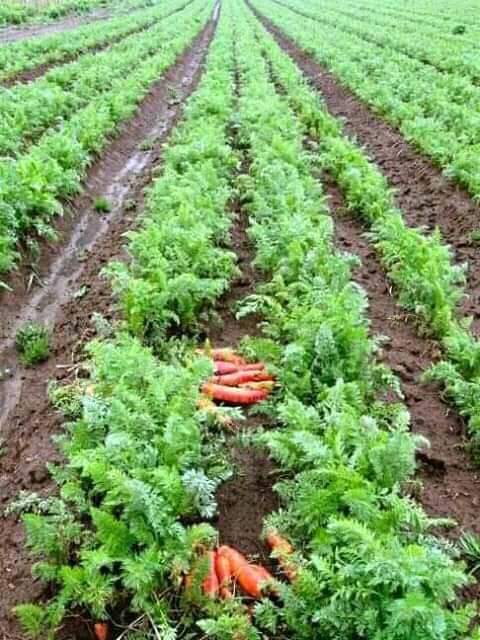
Exploring Carrot Farming in Kenya: Profitable and Beneficial
- Lucrative Opportunity: Cultivating hybrid carrot varieties proves highly profitable in Kenya’s agricultural landscape.
- Health Benefits: Carrots are renowned for promoting vision health and enhancing skin condition, along with aiding weight loss, managing diabetes, and supporting bone and digestive health.
- Versatile Growth: Carrots thrive in diverse climatic conditions, spanning from cold to hot regions. Key areas for cultivation include Central, Coast, Rift Valley, Western, Nairobi, and Nyanza regions.
- Culinary Versatility: Beyond their health benefits, carrots offer versatility in culinary applications. From adding flavor to dishes to creating delightful carrot cakes, they serve a range of culinary purposes.
Ecological Demands of Carrot Cultivation
- Temperature Preference: Carrots thrive in cool to warm climates, avoiding excessively hot regions as high temperatures can negatively affect root development.
- Soil Characteristics: Plant carrots in loose loam soil with a pH ranging from 6 to 6.5, providing optimal conditions for root growth. Avoid poorly drained soil to prevent bacterial growth, which can diminish yields.
- Moisture Considerations: Carrots require adequate moisture levels for optimal growth. Plant in areas with sufficient rainfall or ensure access to irrigation. Dry conditions can lead to root branching and cracking as carrots search for water.
Carrot Farming in Kenya: Varieties
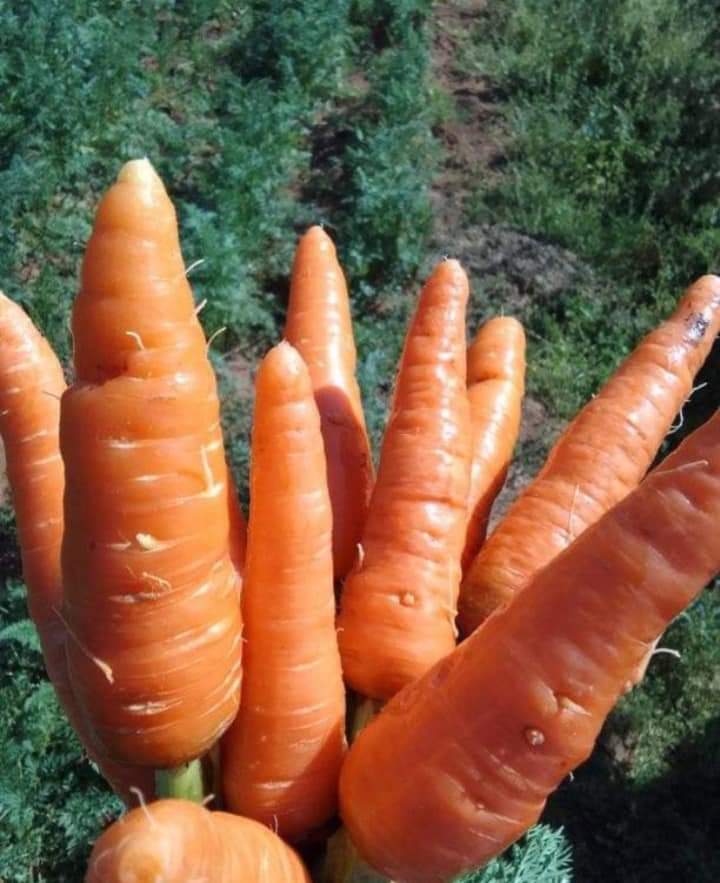
Popular Hybrid Carrot Varieties:
- Nantes:
- Characteristics: Smooth, cylindrical shape; sweet flavor
- Resistance: Resistant to pests and diseases
- Soil Adaptability: Suitable for a variety of soil types
- Chantenay:
- Characteristics: Short, stubby shape; sweet flavor
- Resistance: Resistant to pests and diseases
- Soil Adaptability: Can be grown in various soil types
- Oxheart:
- Characteristics: Large, bulbous shape; sweet flavor
- Resistance: Moderate resistance to pests and diseases
- Soil Adaptability: Suitable for diverse soil types
- Danvers:
- Characteristics: Long, slender shape; sweet flavor
- Resistance: Moderate resistance to pests and diseases
- Soil Adaptability: Thrives in different soil types
- Imperator:
- Characteristics: High yield; moderate resistance to pests and diseases
- Sweetness: Not as sweet as some other hybrid varieties
- Soil Adaptability: Suitable for commercial cultivation in various soil types
Where to Grow Carrots in Kenya
Notable Carrot-Farming Regions in Kenya:
- Central Kenya:
- Regions: Kiambu, Murang’a, Nyeri, Kirinyaga
- Characteristics: Cool temperatures and fertile soils in highland areas
- Benefits: Ideal conditions for quality carrot production; high demand in local markets
- Rift Valley:
- Regions: Uasin Gishu, Nakuru, Bomet
- Characteristics: Altitudes and temperate climate conducive to carrot growth
- Advantages: Availability of irrigation water supports successful farming ventures
- Eastern Kenya:
- Counties: Meru, Tharaka Nithi, Embu
- Conditions: Cooler temperatures in higher altitudes; well-drained soils
- Prospects: Favorable environment for carrot cultivation
- Nairobi County:
- Area: Urban Nairobi and surroundings
- Trends: Rise in urban farming, including carrot cultivation
- Methods: Utilization of small plots and container gardening for local consumption and sale
- Western Kenya:
- Regions: Kakamega, Bungoma
- Environment: Fertile soils and adequate rainfall
- Opportunities: Emerging carrot farming ventures in the region
- Coastal Region:
- Counties: Kilifi, Kwale
- Challenges: Warm and humid climate necessitates careful soil management and irrigation
- Potential: Experimentation with carrot farming despite climatic constraints
Transplanting
Seed Bed Preparation on Carrot Farming in Kenya:
- Soil Preparation:
- Plough fields to a depth of 30 cm.
- Finely prepare and level the soil.
- Raised Seedbed:
- Dimensions: 1 m wide, 10 m length, 20 cm height.
- Suitable for areas with poor drainage or during the long rainy season.
- Furrows for Irrigation:
- Create 40 cm wide furrows between the beds.
Seed Sowing on Carrot Farming in Kenya:
- Direct Seeding:
- Recommended method for establishing carrots.
- Seeding Rate: About 5 kg per hectare.
- Rainfed Crops:
- Trace rows 25 cm apart across the width of the seedbed.
- Drill seeds 5 cm apart within the row at a depth of 1 cm.
- Irrigated Crops:
- Sow 4 rows of carrots at the same spacing along the raised seedbed.
- Seed Handling:
- Mix seeds with sand (2 parts sand: 1 part seed) for ease of handling and uniform spacing.
- Germination:
- Carrot seeds are slow to germinate.
- Cover the seedbed with grass after sowing and water adequately.
- Remove grass carefully once seeds germinate.
Farming Practices
Thinning:
- Spacing Adjustment:
- Carrots are densely sown initially.
- Plants should be thinned to 5 cm spacing within the row.
- Benefits of Thinning:
- Results in uniform and well-sized roots.
- Prevents lodging of plants.
- Timing of Thinning:
- Begin thinning several times from the 3rd week after sowing.
- Thinning can also occur when plants reach 10-15 cm height or during the first cultivation.
- Reducing the Need for Thinning:
- Sow seeds as thinly and uniformly as possible initially to minimize the need for manual thinning.
Intercropping:
- Space Utilization:
- Carrots, with their limited space requirements and early growth habits, are suitable for intercropping with various crops.
- Companion Crops:
- Ideal intercropping partners include tomatoes, lettuce, capsicums, garlic, dwarf beans, onions, parsnips, leeks, small peas, pea mange-tout (snow peas), and radishes.
- Profitable Associations:
- Carrots and leeks form a profitable association.
- Carrots extract nutrients deep in the soil, while leeks extract nutrients near the soil surface.
- Carrots can deter worms from leeks, while leeks can repel flies from carrots.
Cultivation of Carrots:
- Weed Control:
- Carrots grow slowly initially and cannot compete with weeds.
- Shallow cultivation should be repeated to control weeds, especially in the early growth stages.
- Root Protection:
- Deep cultivation may harm roots, which are primarily located within 5 cm of the soil surface.
- Ensure the top of the roots remains covered with soil to prevent greening, particularly with the Nantes variety.
Fertilizer application
Topdressing:
- After germination (21-28 days), apply topdressing with either DAP or NPK 17.17.17 45 days after sowing.
Weed Control:
- Manual weeding is essential, although chemical weeding can also be effective.
- Weeds are vigorous competitors for nutrients, water, and sunlight, so effective weed control is crucial.
- Spraying with fungicides helps to control Powdery mildew.
Root-Knot Nematodes:
- Root-knot nematodes are small “eelworms” that live in the soil and become plant parasites, particularly targeting carrot roots.
- Nematodes enter carrots through the root tip, causing the roots to fork in multiple directions.
- To prevent infestation of new fields, thoroughly clean equipment and tools with water and prevent the movement of infested soil.
- Infested carrots should be promptly pulled up and disposed of.
Watering:
- Watering should be done regularly to maintain soil moisture.
- Insufficient soil moisture can result in longer and thinner roots, while excessively wet conditions can lead to a lighter color of the carrots.
Carrots Farming in Kenya: Pests and Diseases
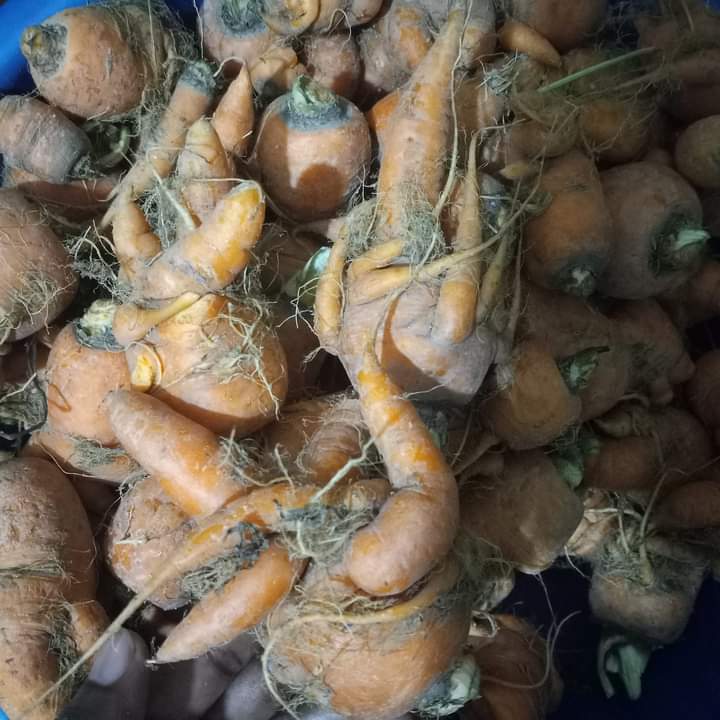
Pests affecting carrot farming in Kenya:
- Carrot Fly (Psila rosae):
- Major pest laying eggs near the base of carrot plants.
- Larvae burrow into roots, causing tunnels and making roots unappetizing.
- Control measures include crop rotation, covering with fine mesh or floating row covers, and planting onions or leeks as companion plants.
- Aphids:
- Small insects sucking sap from carrot leaves and stems.
- Can transmit plant viruses and weaken the plant.
- Control methods include natural predators like ladybugs and parasitic wasps, as well as insecticidal soap or neem oil.
- Wireworms:
- Larvae of click beetles tunnel into carrot roots.
- Proper soil preparation and crop rotation help reduce infestations.
- Cutworms:
- Caterpillars cutting through plant stems at soil level.
- Use of protective collars around seedlings can prevent damage.
Diseases affecting carrot farming in Kenya:
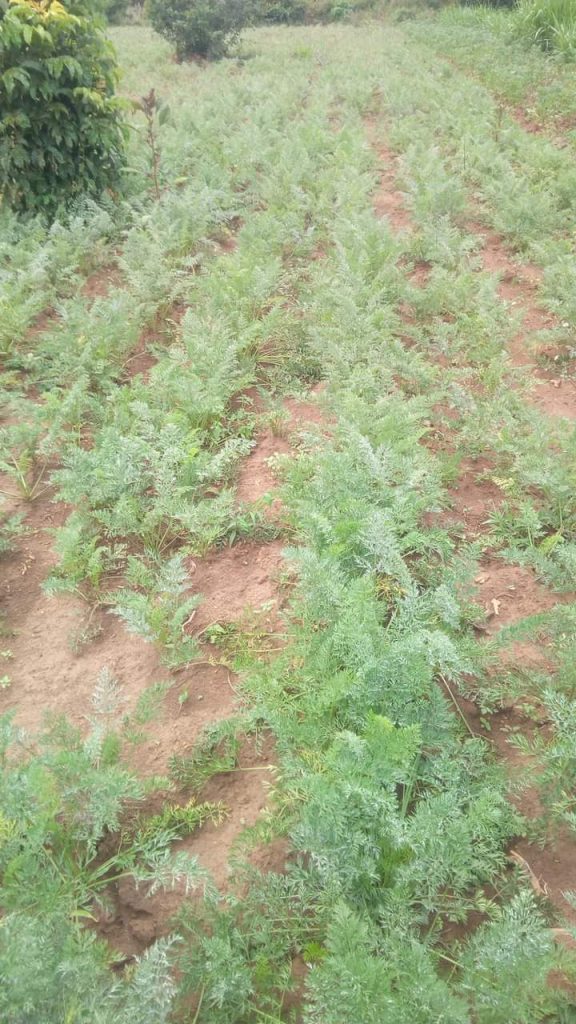
- Aster Yellows:
- Caused by a phytoplasma and transmitted by leafhoppers.
- Leads to yellowing, stunting, and distorted growth in carrot plants.
- Control involves removal and destruction of infected plants.
- Alternaria Leaf Blight:
- Alternaria fungi cause brown lesions on carrot leaves, leading to defoliation.
- Prevention methods include crop rotation and proper plant spacing.
- Cavity Spot (Pythium spp.):
- Soil-borne disease causing brown, sunken lesions on carrot roots.
- Prevention includes proper soil drainage and avoiding over-irrigation.
- Powdery Mildew:
- Fungal disease appearing as white, powdery coating on leaves.
- Control involves regular inspection, proper spacing, and fungicide application.
- Leaf Blight (Cercospora carotae):
- Causes circular, brown lesions with yellow margins on carrot leaves.
- Management methods include crop rotation and sanitation practices.
- Root Knot Nematodes:
- Microscopic roundworms causing galls or knots on carrot roots.
- Control measures include crop rotation, using nematode-resistant varieties, and improving soil health.
Estimating Expenses and Earnings in Carrot Farming: Kenya Case Study

Cost of Carrot Production per Acre:
- Land Preparation:
- Plowing and Harrowing: 20,000 Ksh
- Land Clearing: 3,000 Ksh
- Compost or Goat Manure: 20,000 Ksh
- Total Land Preparation: 43,000 Ksh
- Seeds:
- Carrot Seeds: 3,500 Ksh
- Fertilizers and Soil Amendments:
- Fertilizers (NPK): 4,500 Ksh
- Lime (if needed): 1,000 Ksh
- Total Fertilizers and Amendments: 5,500 Ksh
- Pest and Disease Control:
- Pesticides and Herbicides: 4,500 Ksh
- Irrigation:
- Watering and Maintenance: 10,000 Ksh
- Labor:
- Planting, Weeding, Thinning, Harvesting: 20,000 Ksh
- Miscellaneous Expenses:
- Equipment and Tools: 3,000 Ksh
- Overhead Costs: 5,000 Ksh
Total Production Costs: 43,000 + 3,500 + 5,500 + 4,500 + 10,000 + 20,000 + 3,000 + 5,000 = 95,500 Ksh
Expected Yield: 15 tons
Selling Price: 40 Ksh per kilogram
Potential Revenue from Yield: 15 tons * 1,000 kg/ton * 40 Ksh/kg = 600,000 Ksh
Profit Calculation: Profit = Total Revenue – Total Production Costs Profit = 600,000 Ksh – 95,500 Ksh = 504,500 Ksh
Expected Profits per Acre: 504,500 Ksh.
How Long Does it Take for Carrots to Reach Maturity?
Harvesting typically occurs between 90 to 120 days after sowing, with timing varying based on the local agroecology, particularly temperature. Carrots are considered ready for harvesting when they reach a diameter of 20 mm or more, ensuring they remain young and tender.
In instances where carrots have experienced poor growth or were planted densely, the focus for harvesting shifts from size to maturity and quality. Under certain circumstances, such as market demand or specific agricultural conditions, carrots may be harvested earlier than usual.
Harvesting
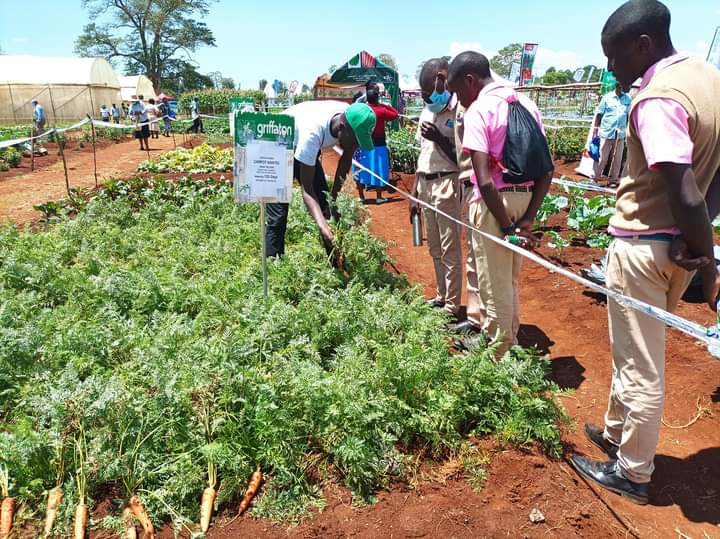
- Harvesting Method:
- Carrots are manually harvested by pulling up the roots at the leaves, preferably when the soil is moist and soft.
- If the soil has dried, a spade or similar tool may be necessary to loosen the soil for easier root extraction.
- Time to Harvest:
- Carrots are typically ready for harvesting 60-85 days after sowing.
- Maturity Indicators:
- Mature carrots should have an orange color internally down to the blunt tip.
- Harvesting for Market:
- Young carrots with a fresh top fetch a good market price.
- Leaving the top on can lead to quicker root drying and reduced marketing period.
- Alternatively, the top can be trimmed back to about 2 cm and packaged attractively.
- Handling Mature Carrots:
- For mature carrots, the tops are completely trimmed down to avoid storage rots before marketing.
- Storage Conditions:
- Carrots can remain in good condition (shelf life) for 100-150 days when stored at 1-4°C with 95-100% relative humidity.
- Carrots should be stored separately from other vegetables to prevent a bitter flavor induced by ethylene.
- Carrots store better when mature, harvested under moist conditions, undamaged, and free of diseases and pests.